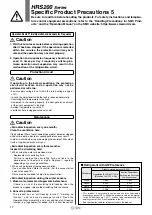
HRS200
Series
Cooling Capacity Calculation
Required Cooling Capacity Calculation
Example 1: When the heat generation amount in the user’s equipment is known.
The heat generation amount can be determined based on the power consumption or output of the
heat generating area — i.e. the area requiring cooling — within the user’s equipment.
*
1
q
Derive the heat generation amount from the power consumption.
Power consumption
P: 20 [kW]
Q = P = 20 [kW]
Cooling capacity = Considering a safety factor of 20%,
20 [kW] x 1.2 =
w
Derive the heat generation amount from the power
supply output.
Power supply output
VI: 20 [kVA]
Q = P = V x I x Power factor
In this example, using a power factor of 0.85:
= 20 [kVA] x 0.85 = 17 [kW]
Cooling capacity = Considering a safety factor of 20%,
17 [kW] x 1.2 =
*
1 The examples above calculate the heat generation amount based on the power consumption.
The actual heat generation amount may differ due to the structure of the user’s equipment.
Be sure to check it carefully.
Example 2: When the heat generation amount in the user’s equipment is not known.
Obtain the temperature difference between inlet and outlet by circulating the circulating fluid inside the user’s equipment.
Heat generation amount by user’s equipment
Q : Unknown [W] ([J/s])
Circulating fluid
: Tap water
*
1
Circulating fluid mass flow rate
qm
: (=
ρ
x
qv
÷
60) [kg/s]
Circulating fluid density
ρ
: 1 [kg/L]
Circulating fluid (volume) flow rate
qv
: 70 [L/min]
Circulating fluid specific heat
C
: 4.186 x 10
3
[J/(kg·K)]
Circulating fluid outlet temperature
T
1
: 293 [K] (20 [
°
C])
Circulating fluid return temperature
T
2
: 297 [K] (24 [
°
C])
Circulating fluid temperature difference
i
T
: 4 [K] (=
T
2 –
T
1
)
Conversion factor: minutes to seconds (SI units) : 60 [s/min]
*
1 Refer to the next page for the typical physical property value of tap water or other circulating fluids.
Q = qm
x C x (T
2
–
T
1
)
= =
= 19535 [J/s]
≈
19535 [W] = 19.5 [kW]
Cooling capacity = Considering a safety factor of 20%,
19.5 [kW] x 1.2 =
24 [kW]
20.4 [kW]
ρ
x qv x C x
i
T
60
1 x 70 x 4.186 x 10
3
x 4.0
60
23.4 [kW]
e
Derive the heat generation amount from the output.
Output (shaft power, etc.)
W: 13 [kW]
Q = P =
In this example, using an efficiency of 0.7:
= = 18.6 [kW]
Cooling capacity = Considering a safety factor of 20%,
18.6 [kW] x 1.2 =
W
Efficiency
13
0.7
22.3 [kW]
Example of current measurement units (Reference)
Heat generation amount by user’s equipment
Q : Unknown [cal/h]
→
[W]
Circulating fluid
: Tap water
*
1
Circulating fluid weight flow rate
qm : (=
ρ
x
qv x 60) [kgf/h]
Circulating fluid weight volume ratio
: 1 [kgf/L]
Circulating fluid (volume) flow rate
qv : 70 [L/min]
Circulating fluid specific heat
C
: 1.0 x 10
3
[cal/(kgf·
°
C)]
Circulating fluid outlet temperature
T
1
: 20 [
°
C]
Circulating fluid return temperature
T
2
: 24 [
°
C]
Circulating fluid temperature difference
i
T : 4 [
°
C] (=
T
2
–
T
1
)
Conversion factor: hours to minutes : 60 [min/h]
Conversion factor: kcal/h to kW
: 860 [(cal/h)/W]
Q =
=
=
=
≈
19534 [W] = 19.5 [kW]
Cooling capacity = Considering a safety factor of 20%,
19.5 [kW] x 1.2 =
q
m
x C x (T
2
– T
1
)
860
x q
v
x 60 x C x
i
T
860
1 x 70 x 60 x 1.0 x 10
3
x 4.0
860
16800000 [cal/h]
860
23.4 [kW]
Q: Heat generation
amount
User’s
equipment
I: Current
Power consumption
V: Power supply
voltage
P
Thermo-chiller
User’s
equipment
T
1
: Outlet
temperature
T
2
: Return
temperature
qv: Circulating
fluid flow
rate
∆
T = T
2
– T
1
Q: Heat generation amount
11



















